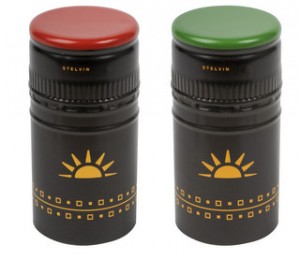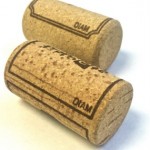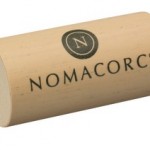Branded closures
A version of this article first appeared in the Drinks Business, February 2009.
Intel has become one of the best know brands of computer chips, and our lives rely on that ‘invisible’ piece of technology. Just as wine relies completely on the closure, so should closure companies pursue the ‘Intel inside’ concept of quality perception?
Such branding would be useful for industry to distinguish different brands of synthetics, of screwcaps, of cork-based products, but would it, even in some years’ time, give consumers appropriate reassurance? Oeneo’s Dean Banister said: “we wanted to do ‘Diam inside’ a few years ago but Intel have the trademark on inside” adding, “a problem driven closures have is consumers don’t know what’s inside and we absolutely want to differentiate our closure from plastics and natural [one-piece] cork.”

Stelvin - clearly branded at the top
There’s the thing … all screwcaps are not equal (how many of us are guilty of saying ‘Stelvin’ when we mean ‘screwcap’?); all corks, natural one-piece and technical, are not equal; and all synthetics are not equal (moulded, single extrusion, co-extrusion). So “before we talk about consumer awareness” said Malcolm Thompson, vice president, marketing and innovation at leading synthetic maker Nomacorc, “we should talk about industry awareness for closure brands. There’s still a tendency to genericise closure types by cork/synthetic/screwcap.”
It’s time to get serious about the individual quality performance factors of specific closure brands. Can some specific brands provide a safe route to quality assurance (notwithstanding application issues; transport and storage issues etc.)? Mark Coleman of Neocork, believes so, saying “given the number of low quality producers on the scene and the various inferior materials they may use to accommodate lower pricing, I think brand is a key proxy for ensuring quality” adding the closure brand “adds another level of assurance for the winery. Our goal is to ensure the winery and its customers can focus on the wine, not the closure.”
Closure disclosure
Having the manufacturer’s brand name or logo on each unit leaving the factory would be a start towards brand differentiation, but not even all the big manufacturers brand every unit. Bruno de Saizieu, commercial and marketing director for Alcan Packaging Capsules, which make Stelvin, said “we put Stelvin on 99.5% of our screwcaps. There is an occasional specific order without the full name on it.” He added: “we want our brand name on our product: firstly it’s important to get our name on, secondly, it’s important for majority of our customers because Stelvin is a sign of quality. It’s why we communicate about Stelvin, not Alcan Packaging Capsules.”
In the spirits business, said Anne Seznec, marketing manager for Guala Closures Group “our logo is important for traceability, and it’s an additional protection for the final consumer, to be sure he’s bought the original bottle with the original screwcap.”
With just two SKUs for wine in their portfolio, Supremecorq’s vice president of global sales, Simon Waller said: “Every single one [is branded] without exception. Inside each [mould] cavity our name is engraved, so our name is on the end of every cork. It’s subtle branding, a reassurance for wine producers that they’re getting the real thing. If we’re selling through distributors and agents, we think it’s smart to have our name on our corks, it’s a guarantee that it’s our brand.”

Diam
It’s a similar story for Oeneo. Banister said for “the last two to three years, when it leaves the factory there’s a Diam, or ‘D’ on it, or ‘Mytik Diam’. We’re not advertising product by putting the logo on, we’re taking responsibility. We’ve made a lot of noise about what Diam can offer. And there’s a lot of look-alike products, so if it doesn’t say its Diam, it’s not Diam.”
It’s manageable with seven SKUs, but the big cork companies offer thousands of SKUs effectively making whatever their customers want: length, coatings, grades for each of a number of different diameter stoppers; technical, single-piece etc. Plus different stopper qualities for bottles that sell between £3 and £3,000. Felipe Neves, sales director for cork manufacturer Alvaro Coelho said: “around 90% of our production is branded. We always try to have our logo [a stylised ‘C’], but we won’t sacrifice the sales. The logo is more a matter between winemakers, who uses who. If they’re happy, the referral is very important for us.”

Twin Top - not often branded
Nor do cork giant Amorim brand each of the 3 billion stoppers they make. Their communications director Carlos de Jesus, said: “we try to brand as much as we can, but the decision is ultimately made by the customer, not by ourselves.” It’s a similar situation with Nomacorc, where Thompson said: “our preference would be to put Nomacorc on every closure, but some of our customers don’t want it. Some of the larger wineries are focused on building their own brands, and want to use the surface area for that purpose. Other customers [are happy] with Nomacorc artwork.”
Quality Assurance
So the top suppliers in each closure sector brand completely or as much as they dare, but with such a fragmented closure supply base, several hundred companies deep, can wineries and influential retailers do more to ensure they meet tight quality assurance standards?
Banister is convinced wine producers need to take more responsibility. He said “it’s hard for suppliers to push other suppliers out of business. The cheapest are there because they don’t have HACCP, GCMS (gas chromatography, mass spectrometry machines), QA, hygiene etc., which are expensive.”
But wine brand owners don’t take these decisions lightly. Carmel Kilcline MW, wine development manager at Percy Fox said: “we’ve used screwcap on Blossom Hill for 18 months, and we’re planning to move Piat d’Or to screwcap in spring 2009 for quality reasons. Our monitoring of consumer attitudes suggest change is welcome. But it’s important to get the technical performance and consumer acceptance aligned.”
The need to combine a good customer proposition and consistent technical performance is reflected at Sainsbury’s where Barry Dick, product technologist for beers, wines and spirits, is reviewing closure policy. He said: “at the moment we’ve got a myriad of different closures which are inconsistent in terms of customer usability, quality and performance, cost and environmental impact.”
Not that one wine brand owner or one retailer linking up with one closure supplier is a good idea. Kilcline said: “For ease of production, most wine producers will have at least two suppliers of packaging material. If any unforeseen issues occur then we have an alternative supplier.” Plus, having a number, even if it’s a small number, of preferred suppliers keep the competitive edge sharp amongst them. She said “the technical team decides closures and we have two or three different producers who have to meet strict technical performance criteria, including on the bottling line.”
Nor does global producer Constellation have a single policy on closures. Simon Thorpe MW, vice president wine development, said: “it depends on destination market because we work in so many different markets, which have varying degrees of acceptance, understanding and interpretation of closures. For example Da Luca Pinot Grigio we automatically close with a screwcap from a quality and consumer perspective, but if we developed this into a market such as the USA, they would want a natural cork.” And he added: “for more premium brands, the decision is made on the style of wine, and what winemakers think is best for the product.”
Communicating closures: B2B or B2C?
Not surprisingly, virtually all communication is with the customers – wineries, retailers – of closure manufacturers. The relationship with consumers is effectively one of invisibility, much like service in a restaurant – you don’t notice excellent service, but you really notice when it’s not good.
 Education is an enduring theme. Thompson said: “there’s still a hump to overcome in the industry with awareness and understanding. And there is an opportunity for wineries in branding. The closure can add additional credibility to wine brand on a quality basis. Quality closures allow winemakers to give consumers a consistent product.” Waller agrees, saying “we have a responsibility to the category to educate wine producers and those who influence the choice of closure.”
Education is an enduring theme. Thompson said: “there’s still a hump to overcome in the industry with awareness and understanding. And there is an opportunity for wineries in branding. The closure can add additional credibility to wine brand on a quality basis. Quality closures allow winemakers to give consumers a consistent product.” Waller agrees, saying “we have a responsibility to the category to educate wine producers and those who influence the choice of closure.”
It’s more pressing for the cork industry, which continues to lose market share. And it’s because the closure market is no longer an accidental monopoly that manufacturers need to turn more attention to communication, of all sorts. Neves said: “the amount of money that would have to be spent on a consumer campaign would be too big for the benefit.” But, he added “we are losing time, our company is increasing sales, but our industry is losing sales because we’re not communicating.”
However, Stelvin has been active. De Saizieu said: “we were in Paris recently, comparing cork and Stelvin with consumers. We do an event per month in France and other countries, with final consumers or with sommeliers. And when they discover something, the first thing you do is talk about it with other people.”
Amorim have used social networking sites to target a younger audience with their ‘Save Miguel’ campaign, which, said de Jesus, “is about bringing the brand to consumer, using a well know actor. The full five minute video has more than 400,000 views on Facebook/You Tube/flickr.”
Though communicating directly with consumers is at an embryonic stage, brand leaders emphasise consistent technical performance will win the day. Thompson said: “when wineries start to transition to a closure like Nomacorc that guarantees a certain level of quality and consistency, they elevate the whole quality game. If you’re not following suit, you differentiate in a negative way.”



